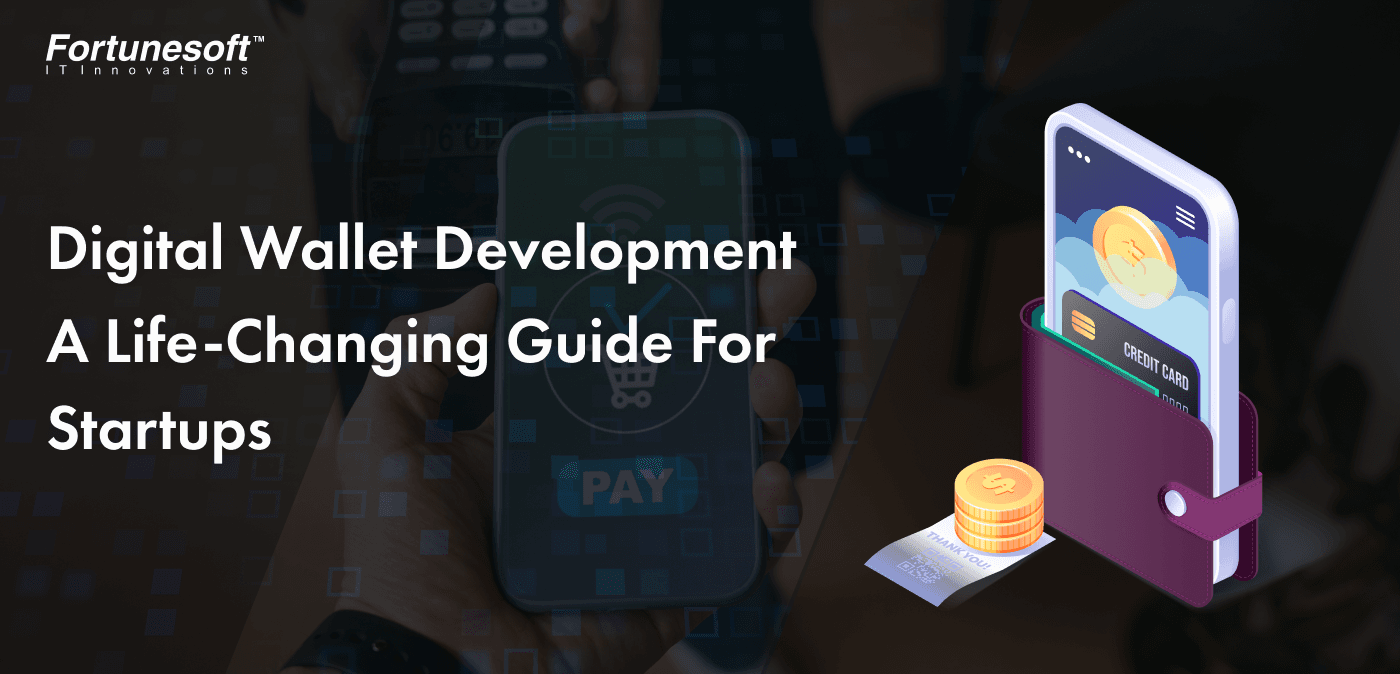 By Jobin June 24, 2025
min read
By Jobin June 24, 2025
min readHow to Create a Digital Wallet?
The digital wallet market is experiencing unprecedented growth, with global transaction values expected to reach $16 trillion by 2028. For enterprises and tech companies seeking to capitalize on this opportunity, understanding how to create a digital wallet has become crucial for maintaining a competitive edge.
Creating a digital wallet involves complex technical decisions, regulatory compliance, and strategic business planning. This comprehensive guide addresses the critical questions executives face when considering eWallet app development, from initial concept to successful market launch.
What is a Digital Wallet, and Why Create One?
Before exploring how to create a digital wallet, it’s crucial to understand the business case driving this technology. A digital wallet is a software application that securely stores payment information, enabling seamless transactions across multiple platforms while reducing operational costs and enhancing customer experience.
It’s essential to define the primary purpose of your digital wallet and identify your target audience. Consider the following:
- Purpose: Will your wallet support peer-to-peer payments, in-store purchases, or digital identity verification?
- Target Audience: Are you catering to consumers, businesses, or both?
- Geographic Focus: Will your wallet operate locally, nationally, or internationally?
Understanding these aspects will guide your development process and ensure your wallet meets the specific needs of your users. Modern businesses create digital wallets to capture transaction fees, improve customer retention, and gather valuable payment analytics. The architecture typically includes user authentication systems, payment processing integration, advanced security protocols, and encrypted data storage mechanisms.
When considering how to create a digital wallet for your business, the primary motivations include reducing payment processing costs, increasing transaction volume, and developing new revenue streams through premium features and merchant partnerships.

Key Features that Drive Digital Wallet Success
Understanding what features to include is critical when learning how to create a digital wallet that meets modern user expectations. Core functionality must strike a balance between security, usability, and business value to ensure market success.
1. Must-Have Security Features
Multi-factor authentication, biometric verification, end-to-end encryption, and real-time fraud detection form the security foundation. These features protect both users and your business from financial losses and regulatory penalties.
2. User Experience Features
The user interface (UI) and user experience (UX) design play a pivotal role in the adoption of your digital wallet. Intuitive interface design, quick transaction processing, support for multiple payment methods, and cross-platform compatibility ensure broad user adoption. Digital wallet development must prioritize seamless user journeys across all touchpoints.
3. Business Intelligence Features
Transaction analytics, spending categorization, budgeting tools, and personalized financial insights differentiate premium solutions. These features provide additional value that justifies subscription models or premium pricing strategies.
4. Integration Capabilities
API connectivity with banking systems, merchant platforms, loyalty programs, and accounting software enables comprehensive financial management. When planning how to create a digital wallet, integration flexibility determines long-term scalability.
Step-by-Step Process: How to Create a Digital Wallet
Creating a digital wallet requires a systematic approach that balances technical requirements with business objectives. The development process involves six critical phases that significantly impact the success of your solution.
Phase 1: Market Research and Compliance Planning
Understanding your target market and regulatory requirements forms the foundation of successful digital wallet development. This phase involves analyzing competitor offerings, identifying unique value propositions, and establishing compliance frameworks for PCI DSS, KYC, and regional financial regulations.
Phase 2: Technical Architecture Design
Designing scalable architecture that supports your business model while ensuring security and performance. This includes selecting appropriate technology stacks, defining API structures, and planning integration capabilities with existing business systems.
Phase 3: Security Framework Implementation
Implementing robust security measures, including end-to-end encryption, tokenization, and multi-factor authentication systems that protect sensitive financial data throughout the transaction lifecycle.
Phase 4: Development and Integration
Building core functionality while integrating with payment gateways, banking systems, and third-party services. This phase requires careful attention to API documentation and testing protocols to ensure the reliable operation of the system.
Phase 5: Compliance Testing and Certification
Conduct comprehensive security audits, penetration testing, and regulatory compliance verification to ensure your digital wallet meets industry standards before launch.
Phase 6: Deployment and Optimization
Launching your digital wallet with proper monitoring systems, user feedback collection, and continuous improvement protocols.

Choosing the Right Technology Stack for Your Digital Wallet
Selecting the right technology stack directly impacts your digital wallet’s performance, scalability, and security. The choices you make during the planning phase significantly impact long-term maintenance costs and future feature expansion capabilities.
1. Frontend Development Technologies
React Native and Flutter provide cross-platform compatibility, reducing development costs while ensuring a consistent user experience across iOS and Android devices. These frameworks accelerate time-to-market for digital wallet applications.
2. Backend Infrastructure Solutions
Node.js, Python Django, or Java Spring Boot offer robust frameworks for handling complex financial transactions and user management. The choice depends on your development team’s expertise and specific scalability requirements.
3. Database Management Systems
PostgreSQL provides excellent security and ACID compliance for financial data, while MongoDB offers flexibility for user preferences and analytics data. Hybrid approaches often deliver optimal performance for digital wallet applications.
4. Cloud Infrastructure Platforms
AWS, Microsoft Azure, and Google Cloud Platform provide essential services, including secure hosting, auto-scaling capabilities, and compliance certifications necessary for financial applications. These platforms reduce infrastructure management overhead while ensuring reliability and stability.
Digital Wallet Development Investment and ROI Analysis
Understanding the investment required is essential when planning how to create a digital wallet. Development investments vary significantly based on feature complexity, security requirements, and compliance needs, but typically deliver substantial returns through reduced transaction costs and new revenue streams.
Foundational Digital Wallet Investment: $25,000 – $50,000
Essential features include user registration, basic payment processing, transaction history, and fundamental security measures. ROI is typically achieved within 12-18 months through reduced payment processing fees and improved customer retention. Suitable for startups testing market demand or internal solutions.
Growth-Focused Digital Wallet Investment: $100,000 – $200,000
Comprehensive feature sets, including multi-currency support, advanced analytics, loyalty program integration, and enhanced security protocols. Expected ROI within 8-12 months through transaction fee capture and increased customer lifetime value. Suitable for established businesses seeking to differentiate themselves competitively.
Enterprise Digital Wallet Investment: $200,000+
Full-featured solutions with extensive integration capabilities, custom compliance frameworks, advanced AI features, and white-label options. ROI is typically achieved within 6-10 months through operational efficiency gains and the creation of new revenue channels. Designed for large organizations and fintech companies.
Investment ranges are estimates based on standard feature sets. Actual project investments depend on specific requirements, integrations, and customization needs. Additional considerations include ongoing compliance audits, security updates, third-party API fees, and customer support systems. Partnering with experienced development companies, such as Fortunesoft IT’s eWallet app development team, can optimize investments while ensuring professional-grade results that meet regulatory requirements and maximize ROI potential.

Security and Compliance Requirements
Security represents the cornerstone of successful digital wallet development. Implementing comprehensive security measures protects your business from regulatory penalties, financial losses, and reputational damage.
1. Encryption and Data Protection
End-to-end encryption, tokenization, and secure key management protect sensitive financial data throughout storage and transmission. These measures ensure compliance with data protection regulations while building user trust.
2. Regulatory Compliance Standards
PCI DSS certification, KYC procedures, and AML protocols form the regulatory foundation for digital wallet operations. Compliance obligations differ across regions, but meeting them is essential for entering a market.
3. Ongoing Security Maintenance
Regular security updates, vulnerability assessments, and incident response protocols maintain a long-term security posture. Establishing partnerships with certified security firms ensures continuous compliance and threat mitigation.
Integration with Existing Business Systems
Successful digital wallet implementation requires seamless integration with your existing business infrastructure. API development enables connectivity with CRM systems, accounting software, and customer management platforms without disrupting current operations.
For enterprise clients, integration with existing payment processors, banking relationships, and financial reporting systems ensures operational continuity. Custom integration solutions cater to unique business requirements while upholding security standards and compliance protocols.
Data synchronization protocols ensure real-time updates across all connected systems, providing executives with accurate financial insights and operational visibility necessary for strategic decision-making.
Launch Strategy and Market Entry
A successful digital wallet launch requires strategic market entry planning, user acquisition strategies, and ongoing optimization protocols. Beta testing with select business partners provides valuable feedback before public release while building an initial user base.
Marketing strategies should emphasize security, convenience, and business value propositions that resonate with executive decision-makers. Partnership development with financial institutions, merchants, and technology providers accelerates market adoption and reduces customer acquisition costs.
Performance monitoring and user feedback collection enable continuous improvement and feature optimization based on real-world usage patterns and customer preferences.
Ready to Build Your Digital Wallet? Here’s Your Next Step
You now understand how to create a digital wallet, but successful implementation requires more than knowledge – it demands proven expertise, regulatory compliance experience, and strategic execution. The difference between a functional digital wallet and a market-leading solution lies in partnering with the right eWallet App Development Company.
What separates successful digital wallet projects?
- Compliance-first development approach that prevents costly regulatory issues
- Scalable architecture that grows with your business expansion
- Security frameworks that protect your reputation and customer trust
- Effortlessly connect with your current business platforms for smooth data flow and streamlined operations
Your decision timeline matters. While you’re evaluating options, competitors are already capturing market share. Digital wallet adoption continues to accelerate monthly, and early market entry provides significant competitive advantages through increased customer loyalty and higher transaction volumes.
Fortunesoft IT’ Innovations has proven a digital wallet development process that eliminates common pitfalls that delay launches and inflate budgets. Our team has successfully delivered enterprise-grade digital wallet solutions for businesses ranging from fintech startups to Fortune 500 companies.
Let’s explore how a digital wallet can fit into your business strategy. Schedule a consultation with our digital wallet specialists to discuss your specific requirements and receive a detailed project roadmap within 48 hours.
Conclusion: Your Path to Digital Wallet Success
Learning how to create a digital wallet represents a significant opportunity for businesses to enhance customer experience while generating sustainable revenue streams. Success requires careful planning, expert development capabilities, and ongoing commitment to security and compliance excellence.
The complexity of digital wallet development makes partnering with experienced providers a strategic advantage. Professional development teams bring specialized expertise, established security protocols, and proven methodologies that time-to-market while ensuring regulatory compliance and market success.
FAQs
1. How much does it cost to develop a digital wallet?
Digital wallet development investment ranges from $25,000 for foundational solutions to over $200,000 for enterprise platforms. The final investment depends on feature complexity, security requirements, compliance needs, and integration scope. Most businesses see ROI within 6-18 months through reduced transaction fees and new revenue streams. Additional costs include ongoing compliance audits, security updates, and fees for third-party APIs.
2. How long does digital wallet development take?
Digital wallet development typically takes 6-12 months from concept to launch. The timeline includes market research (2-4 weeks), technical architecture design (3-6 weeks), security implementation (4-8 weeks), core development (12-20 weeks), compliance testing (4-6 weeks), and deployment (2-4 weeks). Complex enterprise solutions with extensive integrations may require 12 to 18 months.
3. What are the key security measures required for a digital wallet?
Digital wallets should use strong encryption, replace sensitive data with tokens, require multiple forms of user authentication, and support biometric security features. Compliance requirements include PCI DSS certification, Know Your Customer (KYC) procedures, and Anti-Money Laundering (AML) protocols.
Regular security audits, penetration testing, and vulnerability assessments ensure ongoing protection against potential threats. Additional security measures include secure key management, real-time fraud detection, and incident response protocols.
4. Which technology stack is most suitable for building a digital wallet?
The optimal technology stack includes React Native or Flutter for cross-platform mobile development, Node.js or Python Django for backend infrastructure, PostgreSQL for secure data storage, and AWS or Azure for cloud hosting. The choice depends on scalability requirements, the development team’s expertise and the integration needs with existing business systems.
5. Can digital wallets integrate with the existing system?
Yes, digital wallets can seamlessly integrate with existing CRM systems, accounting software, payment processors, and banking relationships through custom API development. Integration features include instant data updates, automated generation of financial reports, and seamless connections with merchant systems. Proper integration ensures operational continuity while enhancing your business ecosystem with digital payment capabilities.
Author Bio


 Facebook
Facebook Whatsapp
Whatsapp LinkedIn
LinkedIn Pinterest
Pinterest






 Start Chat
Start Chat